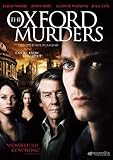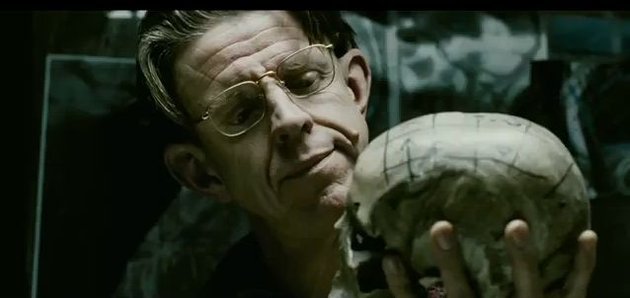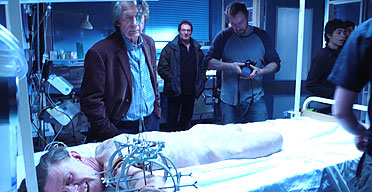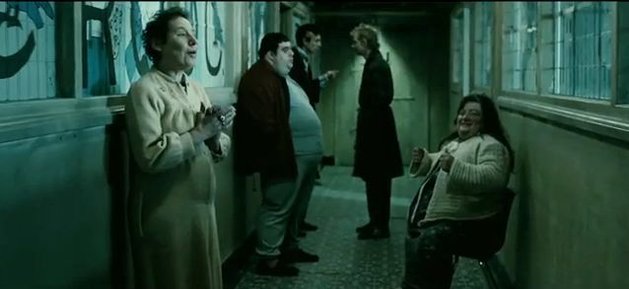 Our first glimpse of the myriad allusions to disability in The Oxford Murders is that of an elderly lady, Mrs. Eagleton, who rents out a room to Martin, a promising young mathematics student who just arrived at Oxford. It is not the intent of Disability Movies to unnecessarily conflate advanced age with disability; we are not shown explicitly what Mrs. Eagleton needed help with or why she had no home health aide–she seems perfectly able to walk to the door, feed herself and play board games–though she is described as a cancer survivor. Her daughter Beth is introduced as her sole caregiver, and vocalizes her resentment of that role to Martin.
Our first glimpse of the myriad allusions to disability in The Oxford Murders is that of an elderly lady, Mrs. Eagleton, who rents out a room to Martin, a promising young mathematics student who just arrived at Oxford. It is not the intent of Disability Movies to unnecessarily conflate advanced age with disability; we are not shown explicitly what Mrs. Eagleton needed help with or why she had no home health aide–she seems perfectly able to walk to the door, feed herself and play board games–though she is described as a cancer survivor. Her daughter Beth is introduced as her sole caregiver, and vocalizes her resentment of that role to Martin.
Martin attempts to meet an old friend of Mrs. Eagleton, prominent mathematician Arthur Seldom. Seldom gives him the brush-off until they happen to visit Mrs. Eagleton’s home at the same time to find her dead, with a broken nose. The police briefly question her daughter, but Martin–who has been attracted to her–assures them she wouldn’t have done it. Instead, he turns their attention to a strange sequence of symbols they notice. The two mathematicians and the police concur that there’s something fishy about this, and speculate wildly about the meaning of the symbols.
(Permit me a brief digression while I inform you of the fleeting shot of a black cab stopping at a curb across the street from our protagonists during one such conversation about the interpretation of the symbols, and once the cab pulls away it becomes apparent that a wheelchair user and companion have disembarked. Huzzah for the wheelchair accessible London cab fleet!)
Here the movie takes a turn for the weird. Seldom and Martin visit an old friend of Seldom’s in the hospital, deranged triple-amputee Kalman. An able-bodied actor was used, necessitating an uncomfortable false bed for the actor and digital trickery to erase the superfluous limbs:
Kalman is a great part. He exists only in flashbacks, and (since flashbacks are usually mute) there is no scripted dialogue. He starts off a young chap in the 1970s, with sideburns, wide lapels and garish ties: the makeup people give me fresh, prosthetic cheeks, my own being too old and sunken. This is just the beginning. Kalman is an Oxford don, driven mad by his inability to solve a complex mathematical quandary. His laboratory becomes a lair; he showers in the kitchen; he throws computer monitors through the window (yay!). In addition to going mad, Kalman develops horrible cancers: both his legs fall off. He gets to buzz around in an electric wheelchair for a while, carrying a skull. Then one of his arms falls off, and he’s last seen lying naked on a hospital gurney, writing one word repeatedly with his remaining hand.
http://www.guardian.co.uk/film/2008/apr/18/2
Kalman is portrayed in a dehumanizing manner; stark naked on his hospital bed, rear end instantly noticable. His remaining arm is encased in what looks almost like an Ilizarov or Taylor Spatial Frame used for bone lengthening, with which he scribbles on paper madly. His arm assemblage is suspended by wires to enable him to write with less fatigue, but succeeds in giving him a tragic, puppetlike appearance. Nurses come and go from the room, leaving the door open while they talk to others in the corridor with nary a thought for his privacy. His visitors don’t even bother to talk to him, not even to see if he’s aware of their presence or will talk about the symbols.
And do I really need to explain the idiocy of suggesting mathematics can be a vector for mental illness? Any student will say their calculus class is driving them crazy, but that’s only a figure of speech.
The trip to the hospital to gawk at Kalman nevertheless proves fruitful, as the two amateur investigators meet a haggard-looking older man in the hospital corridor eager to discuss symbols with them. (The audience is meant to consider this man mentally ill or possibly intellectually disabled, as signified by his raving and bad teeth.)
Also, one nurse in particular catches Martin’s eye, and they embark on a relationship even though he had seemed to be interested in Beth. They share at weird sex scene where they make a mess with spaghetti.
Martin comes to the conclusion that the symbols mean a mass murder is imminent, and feeds his ideas to the police. A check of newspaper headlines reveals a field trip for students with intellectual disabilities, and police attempt to intercept their school bus but are thwarted when the bus swerves into a tree and explodes in a giant fireball. Much is made in the media of the catastrophe, and the students are consistently referred to as “children” and “innocents” (though they look to be young adults).
When the driver of the bus is found to be the same man from the hospital corridor, his motives are revealed; he didn’t orchestrate the accident out of some twisted desire to kill, but to obtain a kidney for his daughter who needed a transplant. (Ethical issues about organ transplantation from murder victims, and from the intellectually disabled who presumably have not given informed consent, are not discussed.)
Martin’s theory regarding the symbols collapses, and he realizes that he should have applied Occam’s Razor much earlier in the investigation. He confronts Beth about Mrs. Eagleton’s death, and she reveals that she murdered her mother in order to clear the way for a relationship with him.





Comments are closed.